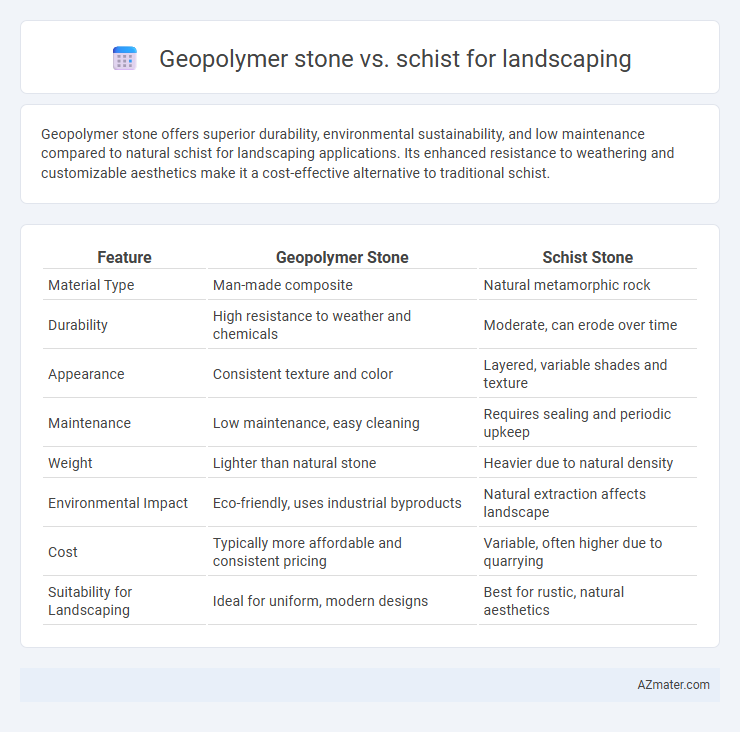Geopolymer stone offers superior durability, environmental sustainability, and low maintenance compared to natural schist for landscaping applications. Its enhanced resistance to weathering and customizable aesthetics make it a cost-effective alternative to traditional schist.
Table of Comparison
| Feature | Geopolymer Stone | Schist Stone |
|---|---|---|
| Material Type | Man-made composite | Natural metamorphic rock |
| Durability | High resistance to weather and chemicals | Moderate, can erode over time |
| Appearance | Consistent texture and color | Layered, variable shades and texture |
| Maintenance | Low maintenance, easy cleaning | Requires sealing and periodic upkeep |
| Weight | Lighter than natural stone | Heavier due to natural density |
| Environmental Impact | Eco-friendly, uses industrial byproducts | Natural extraction affects landscape |
| Cost | Typically more affordable and consistent pricing | Variable, often higher due to quarrying |
| Suitability for Landscaping | Ideal for uniform, modern designs | Best for rustic, natural aesthetics |
Introduction to Geopolymer Stone and Schist
Geopolymer stone, an engineered material made from industrial by-products like fly ash and slag, offers high durability and eco-friendly properties suitable for sustainable landscaping. Schist, a natural metamorphic rock characterized by its foliated texture and rich mineral content, provides a unique aesthetic and strong structural integrity. Both materials are popular in landscaping for pathways, garden edging, and retaining walls, with geopolymer stone emphasizing environmental benefits and schist highlighting natural beauty.
Composition and Formation
Geopolymer stone is an engineered material created by activating aluminosilicate-rich industrial byproducts like fly ash or slag with alkaline solutions, resulting in a synthetic stone with customizable properties and enhanced durability. Schist is a natural metamorphic rock formed through heat and pressure that realign its mineral grains, primarily mica, quartz, and feldspar, into distinct foliated layers. While geopolymer stones offer consistent composition due to controlled manufacturing, schist's composition varies depending on its geographic origin and metamorphic conditions.
Aesthetic Appeal and Color Variations
Geopolymer stone offers consistent color variations and smooth textures, providing a modern, uniform aesthetic ideal for contemporary landscaping designs. Schist, a natural metamorphic rock, showcases rich, earthy tones with unique mineral flecks, creating a rustic and organic visual appeal that varies with each slab. Both materials enhance outdoor spaces, but geopolymer stone excels in color consistency while schist delivers natural, multifaceted beauty.
Durability and Weather Resistance
Geopolymer stone exhibits superior durability and weather resistance compared to schist, making it ideal for landscaping applications exposed to fluctuating climates. Its engineered composition provides enhanced resistance to frost, UV radiation, and chemical erosion, whereas schist, a natural metamorphic rock, can be more susceptible to weathering and surface flaking over time. The long-term stability and minimal maintenance needs of geopolymer stone ensure sustained aesthetic and structural integrity in outdoor environments.
Installation and Workability
Geopolymer stone offers superior ease of installation due to its uniform size, lightweight nature, and consistent strength, allowing for faster placement and reduced labor costs compared to natural schist. Schist's variable thickness and irregular shape require skilled craftsmanship and extended time for accurate fitting and leveling, increasing project duration and complexity. The workability of geopolymer stone, with its engineered composition, ensures precise cutting and shaping, whereas schist's natural formation often leads to uneven surfaces and less predictable modifications.
Environmental Impact and Sustainability
Geopolymer stone offers a significantly lower carbon footprint compared to natural schist, as its production involves industrial by-products like fly ash, reducing reliance on quarrying and mining. Schist, a natural metamorphic rock, requires extensive extraction processes that disrupt ecosystems and contribute to habitat loss. Choosing geopolymer stone supports sustainability through recycled materials and reduced environmental degradation, making it a greener option for eco-conscious landscaping projects.
Cost Comparison and Budget Considerations
Geopolymer stone offers a cost-effective alternative to schist in landscaping due to its lower production expenses and consistent quality, which reduces long-term maintenance costs. Schist, while aesthetically appealing with its natural variations, typically incurs higher upfront costs related to quarrying, transportation, and installation. Budget considerations favor geopolymer stone for large-scale projects or tight budgets, whereas schist may be preferred for premium designs despite the increased investment.
Maintenance Requirements
Geopolymer stone requires minimal maintenance due to its high resistance to weathering, staining, and fading, making it ideal for long-term outdoor landscaping projects. Schist, a natural metamorphic stone, demands more frequent sealing and cleaning to prevent erosion, moss buildup, and discoloration caused by exposure to moisture and varying temperatures. Choosing geopolymer stone reduces upkeep costs and effort, providing a durable, low-maintenance alternative to traditional schist in landscaping applications.
Suitability for Different Landscaping Applications
Geopolymer stone offers high durability, weather resistance, and customizable shapes, making it ideal for modern garden features, pathways, and retaining walls where uniformity and longevity are crucial. Schist, a natural metamorphic rock with unique textures and colors, suits rustic landscaping projects, decorative rockery, and accent walls that benefit from natural aesthetics and variation. Both materials serve distinct landscaping functions depending on the desired visual impact and structural requirements, with geopolymer stone excelling in engineered designs and schist preferred for traditional, organic looks.
Summary: Which Stone is Best for Your Project?
Geopolymer stone offers high durability, environmental sustainability, and consistent color ideal for low-maintenance landscaping projects requiring uniform appearance. Schist, a natural metamorphic stone, provides unique texture and natural variation, enhancing aesthetic appeal in garden pathways and decorative features but may require more maintenance due to its foliated structure. Choosing between geopolymer stone and schist depends on project priorities such as sustainability, texture, durability, and budget constraints.

Infographic: Geopolymer stone vs Schist for Landscaping
 azmater.com
azmater.com